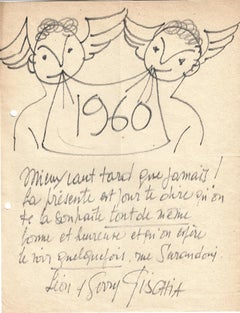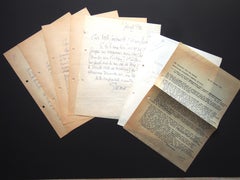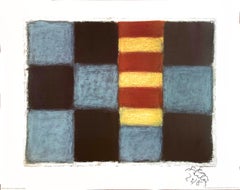Pen More Prints
to
2
Overall Width
to
Overall Height
to
2
2
2
1
1
1
2
2
2
2
2
2
Artist: Léon Gischia
Medium: Pen
Happy New Year - Drawing by L. Gischia - 1960
By Léon Gischia
Located in Roma, IT
Happy New Year is an original black marker drawing on paper with autograph wishing notes by the French artist Léon Gischia to Nesto Jacometti, editor and collector of Graphic art.
...
Category
1960s Surrealist Pen More Prints
Materials
Permanent Marker
Correspondence by L. Gischia to N. Jacometti - 1960
By Léon Gischia
Located in Roma, IT
This Correspondence between Léon Gischia and Nesto Jacometti, written in French and Italian , in 1960, is composed of 7 items, prefectly readable and in excellent conditions, except...
Category
1960s Surrealist Pen More Prints
Materials
Permanent Marker
Related Items
Glaspalast Edition print, Munich Germany, SCARCE when Hand Signed by Sean Scully
By Sean Scully
Located in New York, NY
Sean Scully
Munich 1996 (Hand Signed), 2001
Offset Lithograph print Hand signed and dated by Sean Scully in 2018
Boldly signed in black marker on the recto. Hand signed by Sean Scull...
Category
Early 2000s Abstract Geometric Pen More Prints
Materials
Ink, Permanent Marker, Lithograph, Offset
Savage Journey the American Dream Edition
Located in Hollywood, FL
Artist: Ralph Steadman
Title: Savage Journey the American Dream Edition
Medium: One color silkscreen on White Conventry Rag Paper
Size: 32 × 40 in 81.3 × 101.6 cm
Edition: of 150 + 20 AP
Year: 2017
Notes: From Hunter Thompson's cult classic, Fear and Loathing in Las Vegas, one of the most iconic images in the novel is Savage Journey. Ralph has collaborated with Brian Chambers to create this extraordinary, limited edition, screen print. The edition of 150 have all been signed and numbered in red ink and embellished with his trademark flourish, the splat, in Ultramarine Blue. Each is a unique piece in its own right. They are produced by Kentucky based, Master Printer, Joe Petro III who has collaborated for decades with Ralph on his screen prints including the Hunter Memorial print, Vintage Dr Gonzo...
Category
2010s Surrealist Pen More Prints
Materials
Screen
Twisted Meat Artist
Located in Hollywood, FL
Artist: Ralph Steadman
Title: Twisted Meat Artist
Medium: One color silkscreen on White Rising Stonehenge Deckle Edge Paper
Size: 15 x 22 Inches
Edition: of 250
Year: 2006
Notes: ...
Category
Early 2000s Surrealist Pen More Prints
Materials
Screen
Albert's Old Lady
Located in Hollywood, FL
Artist: Ralph Steadman
Title: Albert's Old Lady
Medium: One color silkscreen on White Rising Stonehenge Deckle Edge Paper
Size: 22 x 30 Inches
Edition: of 25...
Category
Early 2000s Surrealist Pen More Prints
Materials
Screen
Up, Up & Up Yours
Located in Hollywood, FL
Artist: Ralph Steadman
Title: Up, Up and Up Your's
Medium: Three color silkscreen on White Rising Stonehenge Deckle Edge Paper
Size: 22 x 30 Inches
Edition: of 250
Year: 2006
Notes:...
Category
Early 2000s Surrealist Pen More Prints
Materials
Screen
Dancer - Hand-signed and numbered lithograph Leonor Fini Surrealist, 1975
By Leonor Fini
Located in New York, NY
Leonor Fini
Dancer, 1975
Colored etching on Arches paper
11 × 15 in 28 × 38 cm
Limited edition of 185
Category
1970s Surrealist Pen More Prints
Materials
Lithograph
$600
H 11.03 in W 14.97 in
After 50 years of Surrealism The Curse Conquered
Located in Hollywood, FL
ARTIST: Salvador Dali
TITLE: After 50 Years of Surrealism The Curse Conquered
MEDIUM: Etching
SIGNED: Hand Signed
EDITION NUMBER: EA
MEASUREMENTS: 19.75" x 26"
YEAR: 1974
FRA...
Category
1970s Surrealist Pen More Prints
Materials
Etching
Hommage aux Petits Lits Blancs
Located in Hollywood, FL
ARTIST: Salvador Dali
TITLE:Hommage aux Petites Lits Blancs
MEDIUM: Lithograph done for Wally Findlay Gallery
SIGNED: Hand Signed
PRINTER: Mourlot Printers
EDITION NUMBER: 87/2...
Category
1970s Surrealist Pen More Prints
Materials
Lithograph
Vitraux in Four Sheets Puzzle of Life
Located in Hollywood, FL
ARTIST: Salvador Dali
TITLE: Vitraux in Four Sheets Puzzle of Life
MEDIUM: 4 Lithographs
SIGNED: 1 Lithograph is Hand Signed by Salvador Dali
EDITION NUMBER: 1 lithograph is num...
Category
1970s Surrealist Pen More Prints
Materials
Lithograph
Peter Halley, Jablonka Galerie Köln rare abstract exhibition print (Hand Signed)
By Peter Halley
Located in New York, NY
Peter Halley
Jablonka Galerie, Köln (Hand Signed), 1990
Offset lithograph (Hand Signed by Peter Halley)
26 1/2 × 30 inches (ships rolled in a tube 37 x 6 x 6)
Signed by Peter Halley ...
Category
1990s Abstract Geometric Pen More Prints
Materials
Lithograph, Offset, Permanent Marker
$1,000
H 35 in W 6 in D 6 in
Autumn afternoons - Hand-signed numbered lithograph Leonor Fini Surrealist, 1975
By Leonor Fini
Located in New York, NY
Leonor Fini
Pendant les après-midi d'automne, 1975
Colored etching on Arches paper
11 × 15 in 28 × 38 cm
Limited edition of 185
Condition: Excellent condition
Category
1970s Surrealist Pen More Prints
Materials
Lithograph
$600
H 11.03 in W 14.97 in
New York City Plaza (Plaza Fountain)
Located in Hollywood, FL
ARTIST: Salvador Dali
TITLE: New York City Plaza (Plaza Fountain)
MEDIUM: Etching
SIGNED: Hand Signed
EDITION NUMBER: 101/125
MEASUREMENTS: 30" x 22"
YEAR: 1964
FRAMED: No
C...
Category
1960s Surrealist Pen More Prints
Materials
Etching
Pen more prints for sale on 1stDibs.
Find a wide variety of authentic Pen more prints available on 1stDibs. While artists have worked in this medium across a range of time periods, art made with this material during the 21st Century is especially popular. If you’re looking to add more prints created with this material to introduce a provocative pop of color and texture to an otherwise neutral space in your home, the works available on 1stDibs include elements of orange and other colors. There are many well-known artists whose body of work includes ceramic sculptures. Popular artists on 1stDibs associated with pieces like this include Léon Gischia, Actofel Ilovu , Dorothy Dehner, and KAWS. Frequently made by artists working in the Pop Art, Surrealist, all of these pieces for sale are unique and many will draw the attention of guests in your home. Not every interior allows for large Pen more prints, so small editions measuring 0.04 inches across are also available Prices for more prints made by famous or emerging artists can differ depending on medium, time period and other attributes. On 1stDibs, the price for these items starts at $44 and tops out at $225,000, while the average work can sell for $956.
Recently Viewed
View AllMore Ways To Browse
Ewan David Eason
Florida Vintage Travel Posters
Goodyear Poster
Gustav Klutsis
Ihap Hulusi
Ivan Navarro
James B Painter
James Bond Movie Posters
Jan V Roy Posters
John Lennon On Sale
Lait Pur Sterilize
Lake District Vintage Travel Poster
Land Rover Poster
Le Frou Frou Vintage Poster
Leon De Pas
Leon Wuidar
Lillian Snelling
Man Ray Electro Magie



